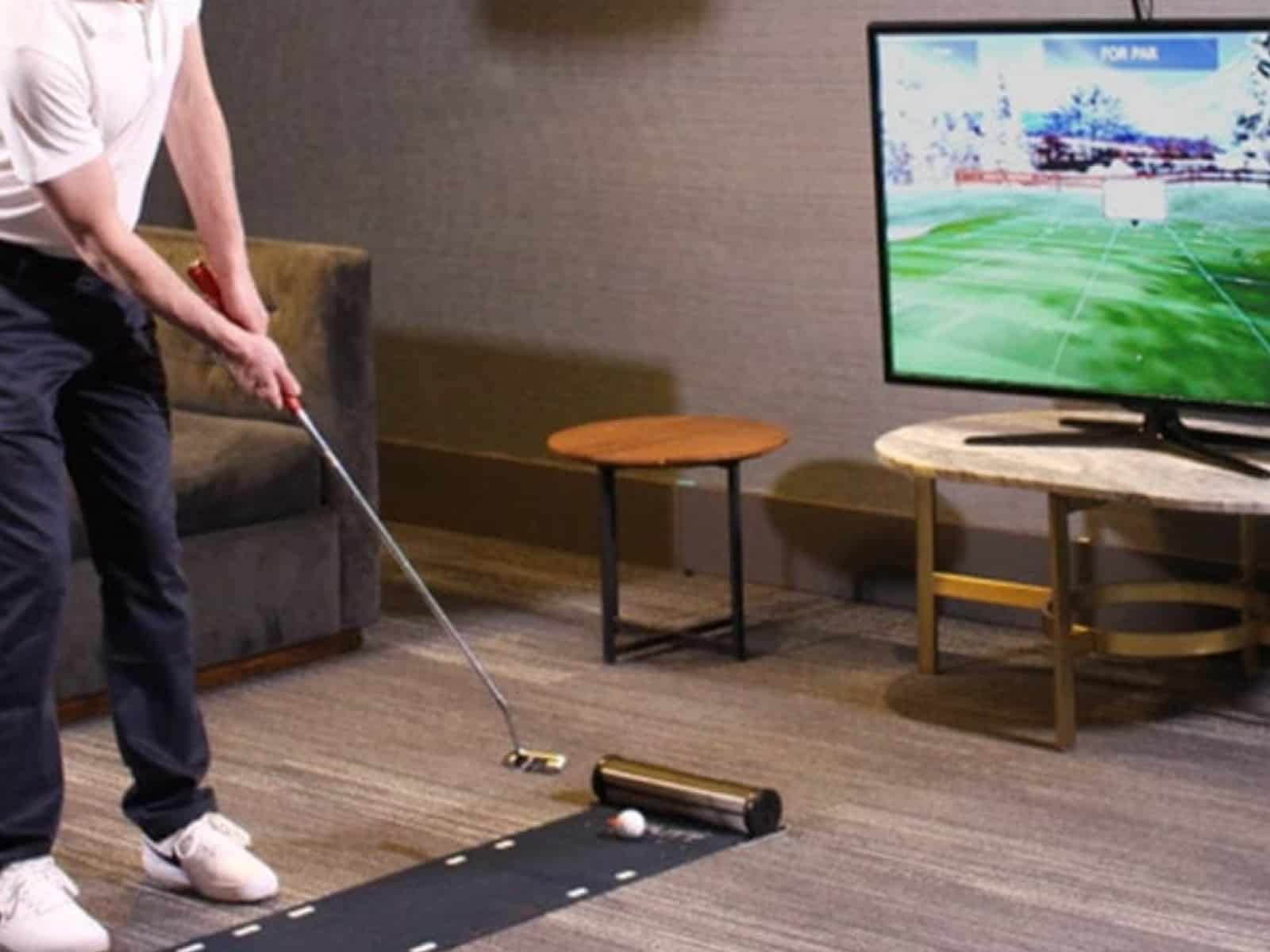While often focused on full swings and long shots, modern simulators also provide valuable functionality for putting and short-game practice. Using golf simulators for putting offers many benefits compared to traditional practice methods.
The main advantage of putting on a simulator is the ability to work on technique, green reading, and distance control without going anywhere. Simulators also record statistics and metrics to help analyze weaknesses and track improvement over time. Visual aids and guides on the simulator screen assist with alignment, aim and green contours.
Putting on a simulator mimics real golf experiences through the use of specialized turf, adjustable slopes/breaks, and ball-tracking sensors. The best simulators use high-speed cameras, infrared sensors, impact sensors, and other technologies to precisely detect ball motion. This data powers the simulation to provide an authentic practice experience.
This article will explore the ins and outs of putting on a golf simulator to help you have an idea of what to expect from your new investment in terms of putting and short-game practice.
However, for golfers looking to improve their putting beyond the simulator, numerous putting training aids are available to enhance accuracy and distance control.
Putting Techniques and Drills
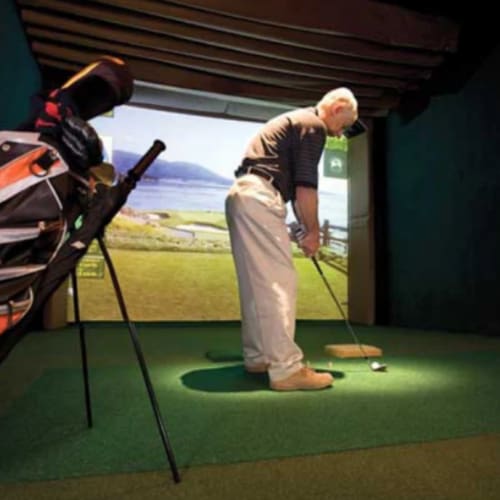
Developing sound putting fundamentals and techniques is essential for success when using golf simulators. The simulator environment allows golfers to ingrain proper form through focused, repetitive practice.
Proper Setup and Form
Having proper setup and form is vital for consistent putting. This includes adopting the correct stance width aligned to the target line, consistent grip and hand placement, good posture and spine angle with eyes directly over the ball, and keeping shoulders, feet and hips parallel to the target.
It’s important to establish a repeatable routine to strike putts accurately by ingraining aspects like ball position, grip pressure and stroke path.
Reading Greens and Controlling Distance
Reading greens and controlling distance are vital skills that can be honed on a simulator. Judging breaks, slopes, and contours takes practice since there is no physical hole.
Distance control involves adjusting tempo, backswing length, and impact power to develop a feel for pace. This touch is developed by hitting putts of varying lengths and breaks.
Chipping and Short Game
In addition to putting, golf simulators allow the practice of related short-game shots. Hitting pitches, chips, and bunker shots at the simulator screen improves technique.
The simulator’s analytics provide useful metrics like launch angle, ball speed and distance. This data aids training for different finesse short game shots.
Drills for Improvement
Targeted putting drills help engrain muscle memory and skills. Useful examples putting drills include:
- Gate drill – Hit putts through a narrow space for alignment
- Uphill/downhill putts – Vary slopes and break
- Lag putting – Focus on distance control by working on longer putts
- Simulation of stressful situations – This helps recreate pressure to get used to stressful situations and know how to deal with them.
Repeating such drills builds putting proficiency. Using a simulator indoors complements on-course practice.
Putting Methods on Golf Simulators
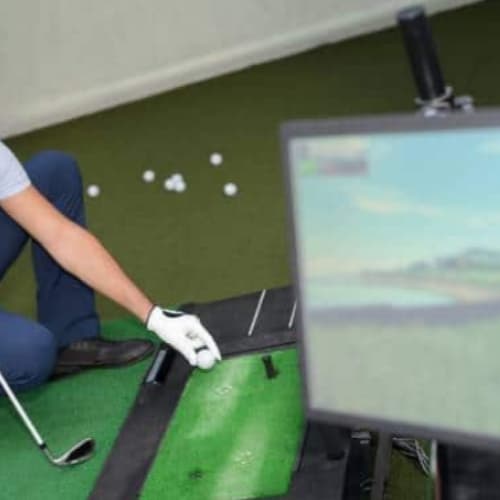
Golf simulators offer various options for registering and inputting putts during a round. The putting method impacts factors like pace, convenience, and realism.
Auto Putt
With auto putt, once a putt is hit, the simulator automatically inputs the number of strokes based on the distance to the hole. This allows speedy play without manual input. However, it reduces realism since putts are not actually “holed”. It’s the software taking care of the putts.
Manual Putt
Manual putt requires the player to physically make the putt, and then the system tracks the ball and simulates the shot on the screen. This enhances realism but slows down the pace of play.
Gimme Range
Setting a gimme range means putts within a certain distance are automatically scored as holed without finishing the putt. This speeds up simulator play, but it is not the most realistic option.
Separate Putting Green
Some simulators offer optional separate putting greens. This provides the most realistic experience of holing out each putt on an actual green surface. Still, this option requires a larger space to install the simulator and the separate putting green.
The putting method should align with the players’ priorities like pace, realism, and convenience when using a golf simulator.
Features and Considerations for Putting Simulators
When selecting a golf simulator for putting practice, there are certain features and factors to evaluate. The simulator’s capabilities and setup process impact the realism and effectiveness of the experience.
Key Features to Look For
The most important features to prioritize in a dedicated putting simulator are those that help recreate the true feel of real greens and provide useful feedback.
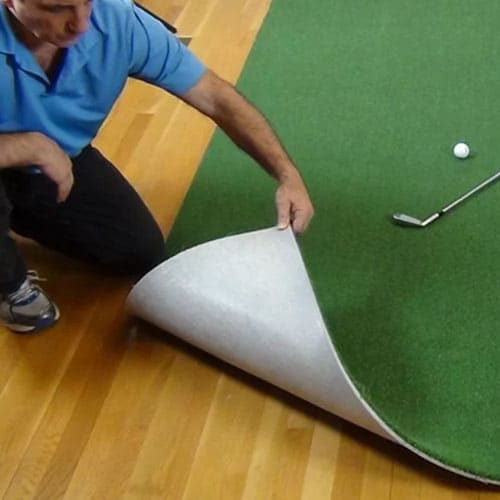
Having artificial turf and adjustable green speeds allows customizing the speed to match real conditions. Slopes, breaks, and contours can also be varied to simulate the challenges of reading actual greens.
Precise ball tracking sensors paired with detailed analytics let you analyze each putt and identify areas needing improvement. A library of simulated courses adds variety to practice sessions. Visual alignment guides also help develop skills for proper aim and reading putt breaks. With quality performance data, you can track your progress over time.
Setup Considerations
Properly setting up a golf simulator for productive putting practice requires attention to several factors. Enough space is needed to allow a full putting motion and to position the screen appropriately. Careful assembly and placement of the components according to instructions ensure proper functioning.
Moreover, connecting all electronics like sensors, cameras, and screens and calibrating the system configures the simulator for accurate performance. Adjusting customizable settings like green speed, slope, and break helps the simulator to match realistic conditions.
Also, selecting the appropriate practice mode or virtual course provides the desired putting experiences. Other important setup considerations include location, lighting, mounting, and cable management. Addressing these details creates an optimized simulator environment.
Technology for Indoor Use
Specialized technology enables highly accurate simulation for indoor putting. Radar-based systems like Trackman can detect ball motion even in an enclosed space by using dual radar and optical sensors. Precise optical tracing of the ball’s movement provides detailed data for analysis. Still, photometric units using high-speed cameras are the best choice for indoor use, as radar units tend to lose a bit of accuracy indoors.
Additionally, ball tags, impact sensors, and high-speed cameras further enhance shot tracking to gather meaningful statistics. However, certain limitations exist such as accurately reading very short putts. When thoughtfully designed and used, these technologies transform indoor simulators into valuable practice tools that build skills to complement on-course training.
Top Golf Simulators for Putting
Several leading golf simulator systems stand out for their putting functionality and realism. These include the following:
Trackman
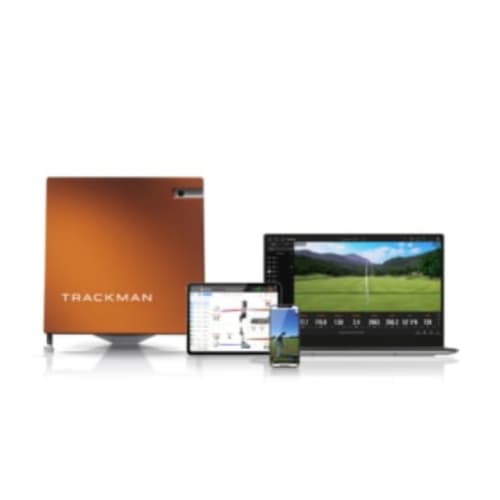
Trackman uses a combination of radar technology, sensors, and high-speed cameras to precisely trace club and ball motion. It excels at tracking full shots but also performs well for chipping and putting. The system provides detailed shot data for analysis. This is a professional system that includes software sections dedicated to short-game practice.
FlightScope X3
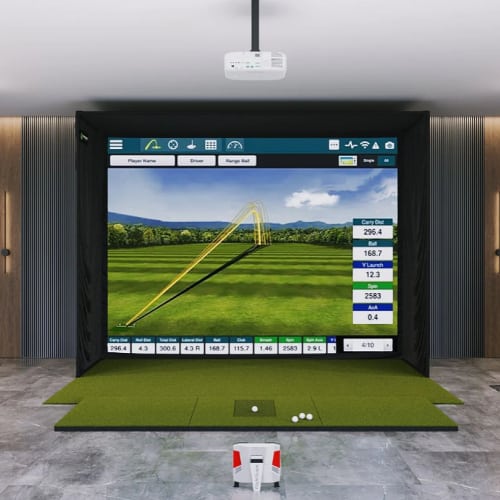
This launch monitor uses the company’s Fusion Tracking technology, which combines Doppler radar and a high-speed camera to track club and ball movement accurately. The high sensor precision suits putting simulation. It captures critical data like face angle, path, and distance.
We suggest the Flightscope X3 SIG12 sim package if you want a professional-grade system to practice all shot types; we also suggest upgrading to the SIG12 golf sim flooring to have an excellent mat with built-in putting cups where you can improve your putting and short-game skills.
Lately, Flightscope introduced an upgrade for the X3: the X3C launch monitor, with the “c” referring to the improved carbon fiber casing that improves durability while reducing weight. The device also sports improved kickstand and auto-leveling system.
Foresight Sports GCQuad
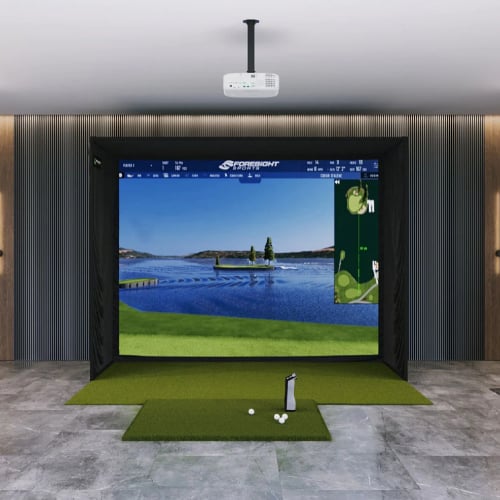
The GCQuad uses advanced camera systems and image processing to accurately read ball data like speed, direction, and spin. The quad-camera system provides some of the most accurate data points related to all game aspects.
You can include the Putting Analysys addon to get important data about your putting performance; and the included FSX2020/ FSX Play suite provides plenty of features and game modes to purposefully practice putting.
Our recommendation for a full system is the Foresight Sports GCQuad SIG10, which also comes with an optional SIG10 sim flooring that allows you to practice your putts in a realistic and authentic environment.
SkyTrak +
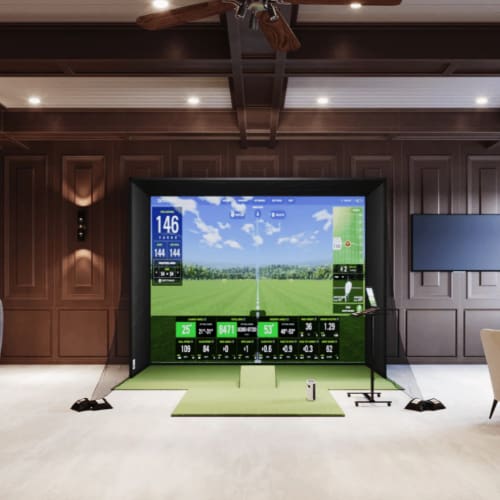
The Skytrak Plus is a great successor to the original Skytrak; it brought a plethora of innovations such as improved accuracy, faster processing and the combination of Dopper radar and photometric technologies that allows for tracking both the ball and club.
One of the best packages you can choose for putting practice is the Skytrak Plus Swingbay sim package, which provides good-quality hardware and software components that provide a very good simulation experience, with the possibility to practice all game aspects, including putting.
HD Golf
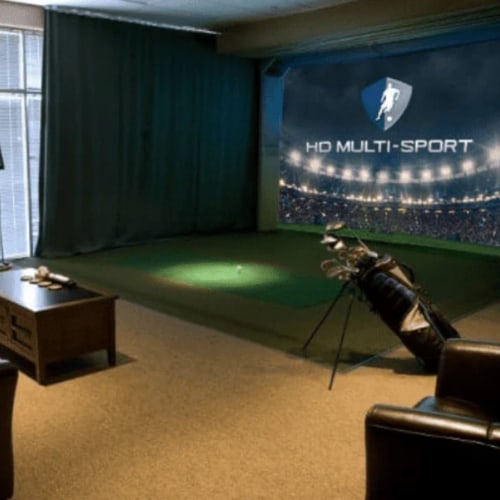
HD Golf uses high-resolution cameras and image processing algorithms to precisely track the ball during and after impact. This provides excellent simulation for short game practice. HD Golf’s systems are some of the most advanced and innovative in the industry today, and they are priced accordingly.
HD Golf’s sims come in two variants: the HD Golf Ultimate Entertainment Package and the HD Golf Ultimate Training Package.
Exputt RG 500D
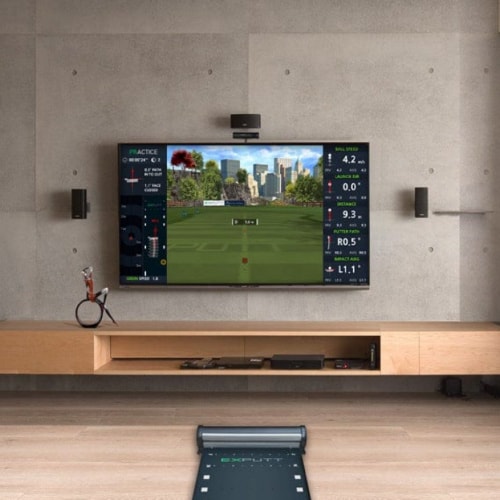
The Exputt RG 500D Real-Time Putting Sim is a dedicated putting system using video technology and built-in sensors to capture key putting metrics for analysis.
This is the best putting-only golf simulator available today. It focuses solely on putting and does a great job helping you improve your skills really fast.
Check Also: Best Golf Simulators For Putting – Reviews & Buying Guide
Persisting Issues with Putting on Current Golf Simulators
While golf simulators provide many benefits for indoor putting practice, some limitations and issues still exist. Being aware of these can help you set realistic expectations.
One key issue is accurately reading very short putts. Most simulator sensors struggle to precisely track ball motion over tiny distances. This can lead to inconsistent results for tap-in putts.
The lack of a real physical hole can also make judging speed and visualization challenging. Developing “feel” for pace and line without a cup as a target takes adjustment.
Even high-end simulators cannot perfectly replicate every subtlety of actual greens like moisture, grain and imperfections. Minor inconsistencies between simulated and real surface performance may persist.
Additionally, simulator setup factors like lighting, calibration, component wear, and turf maintenance impact accuracy. Poor maintenance can degrade sensor readings over time.
One last issue is the perception of depth of field, which is missing in virtual systems. For example, you need to make a 30′ putt, but the distance you have in front of you is much lower; it won’t be easy to judge how much power to use to make the putt. Getting used to putting on a golf sim takes some adjustment time.
While simulators continue improving, golfers should supplement with real course practice to experience variables that technology cannot yet fully recreate. Combining both maximizes development.
Frequently Asked Questions
Let’s answer some widely asked questions related to golf sim putting capabilities; if you still have any questions, you will most probably find the answer here.
How accurate are golf simulator putting results compared to real greens?
The accuracy varies based on the simulator technology. High-end systems with precise sensors and ball tracking can replicate real results quite well. Limitations still exist for very short putts.
Overall, however, simulators are becoming more and more accurate and realistic for putting.
Should I invest in an at-home golf simulator solely for putting practice?
This depends on your needs and budget. For avid golfers focused on comprehensive putting improvement, a quality simulator is a worthwhile investment.
If you are only interested in putting practice, the Exputt 500D (mentioned earlier) is our best recommended pick for putting practice.
What simulator features are most important for realistic putting?
Key features include adjustable greens speeds, customizable slopes/breaks, realistic artificial turf, and advanced ball tracking sensors and algorithms. These enhance realism.
Some advanced systems even have a dedicated software section that allows you to practice putting and short game and get very accurate data to help you improve.
How can I maximize my putting practice time on a golf simulator?
To maximize your putting practice time on a golf simulator, you can use varied drills, games and challenges that will get the most from simulator time. Don’t forget to complement with course practice.
Also, analyze simulator data to keep improving. Try to vary locations and stances and practice distance control.
What metrics can I track with a golf simulator for putting analysis?
Useful putting metrics include face angle, swing path, impact location, ball speed, launch angle, distance, aim, alignment, green contours, and more. The number of data you get depends on the system you have, with premium packages from Foresight Sports, Flightscope, Uneekor, and HD Golf usually providing more metrics than mid-range or entry-level systems.
Conclusion
Golf simulators have opened up new possibilities for putting and short game practice indoors. Using the latest sensor technologies and simulation software, modern simulators can provide impressively realistic putting experiences.
While simulators continue to improve, they cannot yet perfectly replicate every nuance of real greens. As such, combining simulator practice with in-person course time is ideal for comprehensive putting improvement. Technology limitations, like reading very short putts, should be considered.
Continued innovation in sensor accuracy, data analytics, simulation realism, and customized feedback will further enhance the value of indoor putting simulators. As adoption increases, they are poised to transform golf learning and enjoyment for enthusiasts of all skill levels.
Thanks for reading!


